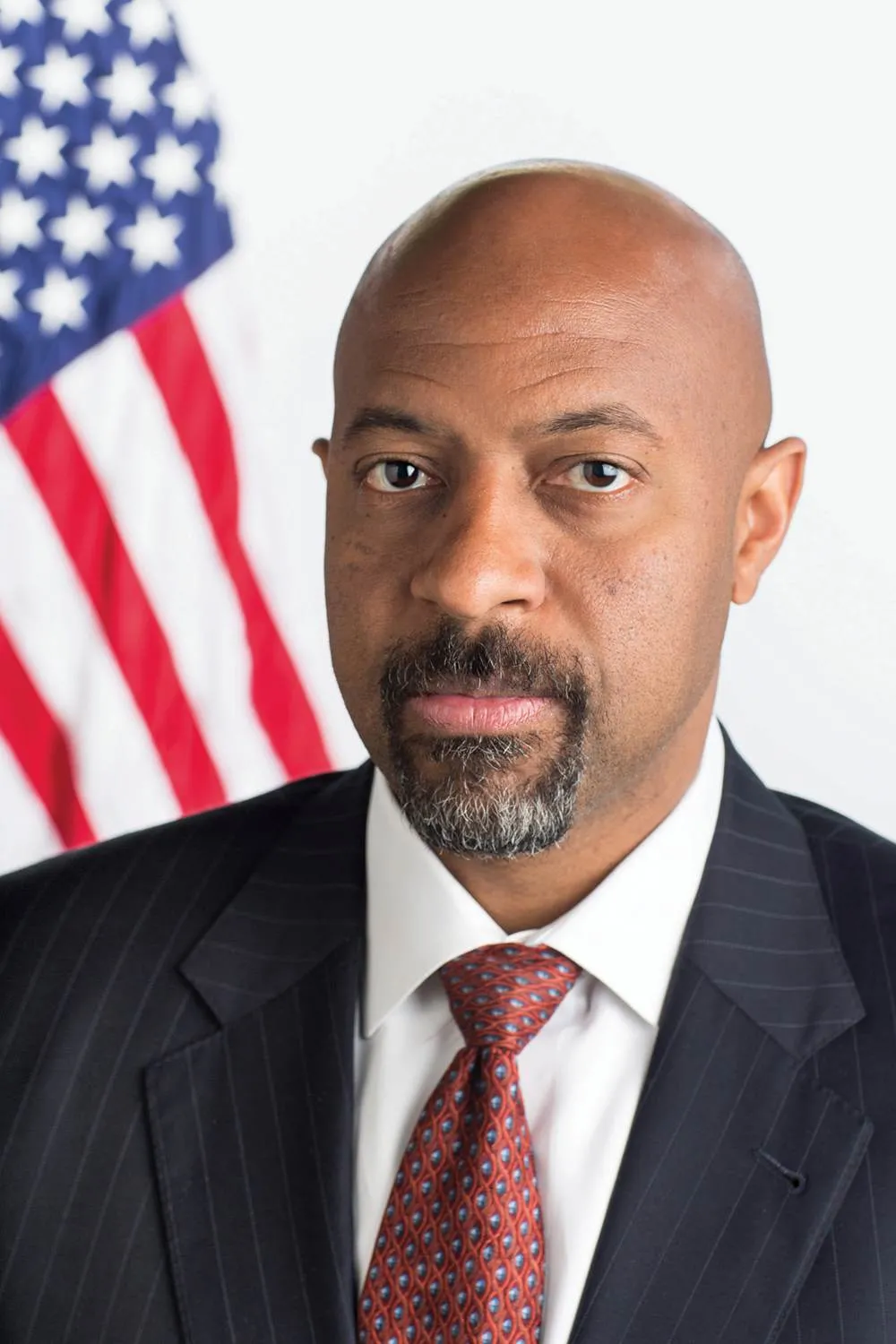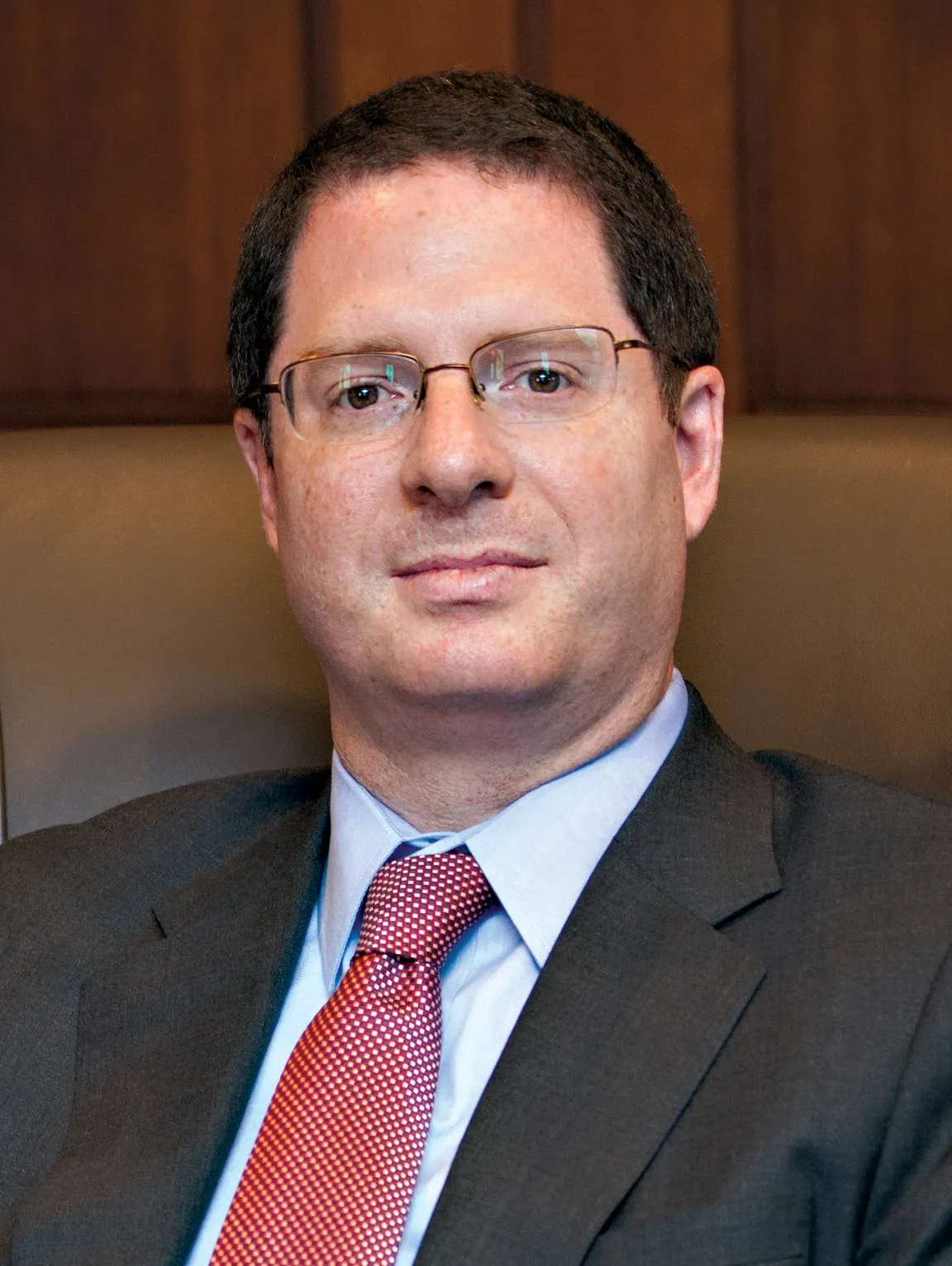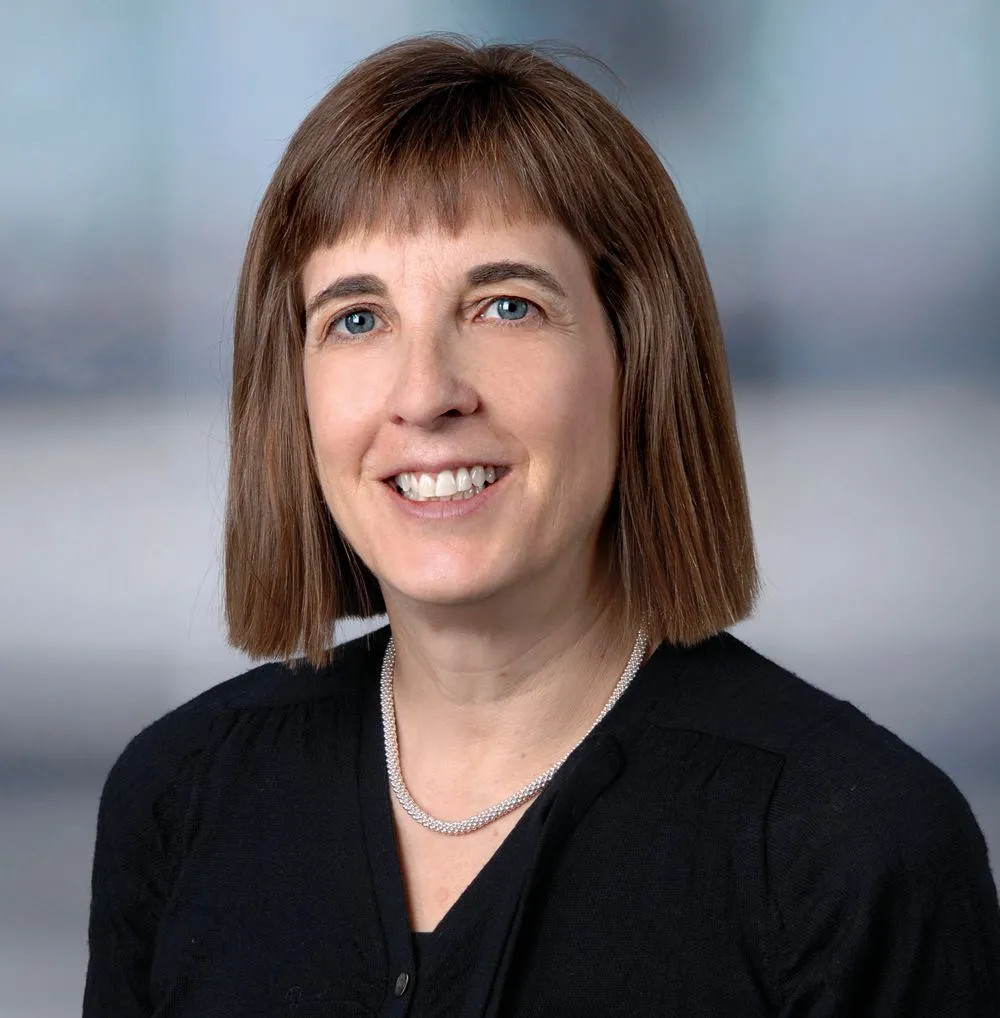The Domino Effect of Kapnick: Bold New Program Brings Interpersonal Savvy of Business to Law
Ian Cohen, ’17, was taking a risk.
Not in a weighty, life-changing way — although he was just three days into Law School orientation and feeling a bit apprehensive — but in the more immediate sense. He was about to fall and, theoretically, his classmates might not catch him.
But he was in a trusting, even playful, mood — and there didn’t seem to be much to lose. And so on a sunny September day, out in the woods in Chicago’s western suburbs, Cohen announced his intention (“taking a risk”), waited for a response (“go for it”), and allowed his body to spill back toward the sea of green t-shirts.
Within a few hours, he’d be further outside his comfort zone than he expected.
***
Usually “trust falls” like this are more the stuff of corporate leadership retreats, not the preamble to an elite law school education. In fact, much of the new Kapnick Leadership Development Initiative that brought Cohen and his classmates out to the woods—and later would have them rethinking first impressions, practicing nonverbal speech, and learning the subtleties of influence—felt like a departure from the typical law school orientation.
And, of course, it was. The bold initiative, which launched last fall, is also powerful, meticulously connected to real-world needs, and effective.
The Law School is doing something that is unprecedented among its peers: it is investing significant resources in helping students hone the communication, self-assessment, and teamwork skills that law firm and corporate leaders have repeatedly identified as critical differentiators in a market that is more collaborative, faster-paced, and less forgiving than it was a decade ago. Built around leading research and mandatory for all new 1Ls, Kapnick is at the forefront of a movement to bring the interpersonal savvy of the business world to legal education, which at the Law School means acknowledging an inescapable shift without sacrificing the analytical gravitas of the academic program.
“We start with the brightest students in the country, and then, through Kapnick, we equip them with the skills to leverage that intellect in the most effective way possible, both in Law School and professionally,” said Dean Michael H. Schill, the Harry N. Wyatt Professor of Law. “Our graduates have always been well equipped to compete at the highest levels of law, business, and government — and in today’s legal market that means combining exceptional intellectual preparation with an outstanding ability to build relationships, trust, and influence. I am tremendously proud that our law school is the first of our peers to develop a leadership program of this caliber, and I am delighted to report that our debut effort exceeded our greatest expectations.”
Indeed, other law schools are already calling, looking to copy or learn from the Kapnick model.
“I imagine that within 10 years every law school will have some type of program like this,” said Kapnick facilitator Jasmina Vajzovic, ’15. “Law firms and the legal profession are moving toward a new culture—it’s becoming more business-oriented, more people-oriented. Law schools are going to have to help students develop these skills because otherwise they’ll be sending lawyers out into the world with only the knowledge, which is just half of what they need.”
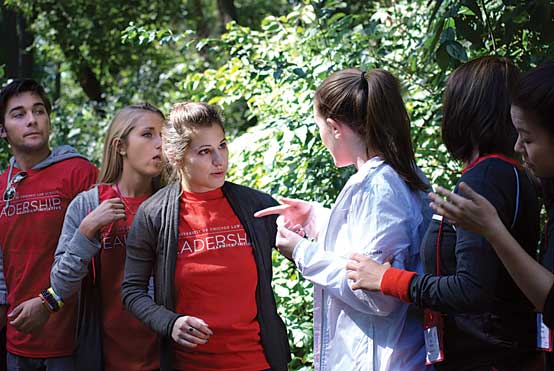
The Breckinridge cohort negotiates an exercise where students rearrange themselves in height order on a beam without falling off.
The program, a series of eight modules that run mostly during orientation, grew out of feedback from members of the Law School’s Visiting Committee and is the result of a $2 million joint gift to the Law School and Booth School of Business by Scott, JD/MBA ’85, and Kathleen Kapnick, ’84. The idea was to develop a program modeled on Booth’s well-respected experiential Leadership Effectiveness and Development (LEAD) course, which was the first of its kind when it was launched more than two decades ago. Tailored to the Law School, Kapnick is run jointly by the leadership development staff at Booth and the Law School’s Office of the Dean of Students.
Following the Booth model, carefully selected student facilitators — twelve third-year law students and twelve second-year Booth students — guide new 1Ls through a series of robust workshops designed to foster self-awareness and lay the groundwork for gradually developed, but enduring, leadership skills. The facilitators receive intensive training the previous spring, experiencing the Kapnick modules firsthand, working with a mentor, and developing their own leadership styles.
The program begins in September with a two-day retreat, during which the students visit the outdoor ropes course and participate in a variety of team-building activities that force them to acknowledge, and even reevaluate, their natural tendencies. Facilitators add unexpected obstacles — banning verbal communication just as a team is hitting its stride, for instance — and watch to see whether participants adjust and solve or fumble and stall. In classroom modules back on campus, students receive feedback on first impressions, explore how their own personality traits influence leadership style, learn to “captivate the audience” through public speaking, develop strategies for building effective and influential relationships, and examine business-relationship norms of other cultures. In one exercise, they work one-on-one with a facilitator to analyze a video of themselves participating in a group discussion — a sometimes uncomfortable, but often enlightening, process.
“Self-awareness is crucial, but it isn’t something that always comes naturally,” Dean of Students Amy Gardner said. “Becoming aware of the role you play in a group, both positive and negative, and learning to see yourself through the eyes of others can inform and improve your interactions immensely. It can be tough to see a video of yourself and realize, for instance, that you tend to talk over other people or that you project a lack of confidence when you speak. But it is much better to learn these things as a 1L so you can walk into your first job ready and able to win the trust of your peers, clients, and superiors.”
A growth in self-understanding was one of the two most immediate and noticeable effects of Kapnick. The other was the striking bond that formed among the 1Ls.
“You could see it as soon as you walked into the Green Lounge,” Gardner said. “We have always had camaraderie at the Law School — it’s a benefit of being small — but there was a level of closeness and trust that just happened sooner. That will pay off in so many ways, both during law school and after graduation.”
One 3L facilitator noticed the difference during a phone conversation with her sister, a first year at Harvard Law. “She was still doing a lot of stuff on her own,” the facilitator said. “They aren’t doing anything like this at Harvard.”
Several faculty members saw the change, too.
“The students have seemed more collegial and more aware of the impression they are making on others,” said Douglas Baird, Harry A. Bigelow Distinguished Service Professor of Law. “I must admit that I am quite pleasantly surprised.”
A number of first-year students described a Kapnick domino effect: the bonding grew into camaraderie and mutual respect, which made them feel more supported and, therefore, more willing to speak up, reach out, and take chances.
“One of the most terrifying things about law school is the prospect of being cold called, and having an embarrassing cold call, in front of all these people you’re supposed to be competing with,” said Gabe Rossman, ’17. “But I really think the whole emphasis on warmth and the friendship we built during Kapnick has mitigated a lot of people’s stresses and fears of being put on the spot. A number of people have said that.”
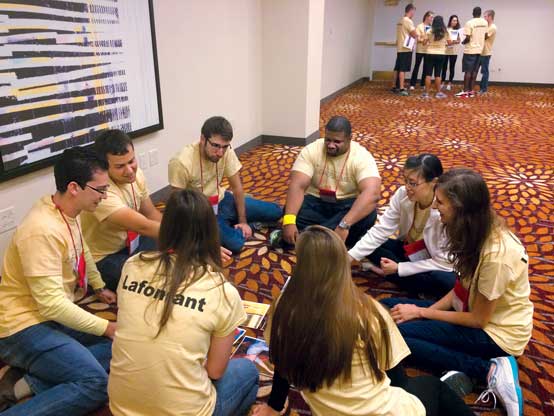
At the retreat, part of the Lafontant cohort (cohorts are named for prominent Law School faculty or alumni) works on a task involving selling an imaginary item of their own invention.
In a survey conducted after Kapnick concluded, almost 95 percent of students said they gained insights about working in teams, 94 percent said they received valuable feedback that would help their careers, and 82 percent said they learned how their own personalities might influence their work strategies. Nearly 98 percent said they bonded with their Bigelow sections and other classmates.
“If we can help students coming into a new environment at an important time in their lives create some connections that allow them to assimilate more rapidly and feel comfortable, we buy a lot of goodwill,” said Jeffrey Anderson, former Associate Dean for Leadership Development at Booth and one of the program’s architects. “And that opens their minds to the stuff that follows.”
Those open minds may well be why the Kapnick dominos continued to fall in the weeks and months after the program ended. As fall quarter progressed, the lessons settled in, perspectives continued to widen and shift, and students began to make subtle changes that hinted at the enduring legacy to come.
***
Back at the retreat, Ian Cohen had just dropped into his teammates’ waiting arms. Not so bad.
Heading into Law School, and into the Kapnick program, Cohen hadn’t known quite what to expect. He’d worried that an elite law school would invite cutthroat competition and anxious intensity. Although he’d had leadership opportunities during his undergraduate years at Cornell and on internships in a New York State assemblyman’s office and in the Kings County (NY) District Attorney’s Office, he didn’t think of himself as particularly take-charge when it came to group collaboration. He knew he had a tendency to be shy and hang back at first, and he’d always assumed that only the most assertive people excelled as leaders.
But out in the woods, that began to change. After his classmates caught him, any remaining concerns about feeling silly dropped away. “We were all laughing together,” he remembered. He found himself entirely in the moment, focused on the task at hand. The fall was part of a more complex challenge: the group had to figure out how to get each member to the opposite side of a giant rope web without touching the rope or, in most cases, using an opening more than once. The backward drop was the first step toward being lifted, and it required one to have at least a modicum of faith in the team. The exercise was tricky, odd, and … fun.
Throughout the course, similar scenes requiring varying levels of cooperation, communication, and humor were playing out: one group was trying to balance on a wood seesaw, and another was trying to cram themselves onto a 2-by-2-foot platform at the same time. “OK, everyone get as sideways as you can!” a student in the latter group called out as they stepped forward. They managed to hold their spots to the count of nine.
Another group was lined up on a log, trying to rearrange themselves in height order without falling off.
“I’m perfectly comfortable with this because I salsa dance,” one student told her team. A moment later, when she stumbled, a teammate caught her and the group was able to continue. “We’re at the end!” the woman cheered when she finally arrived at the perfect spot for her 5-foot-2 ½-inch height.
At the web, Cohen’s group was determined, debriefing after failed attempts but always rebounding from mistakes.
When it was Josephine Oshiafi’s turn, the group was ready for a win.
“I trust you guys,” she said, falling back until her pink shoelaces were even with her head. The group passed her over the top of the web, avoiding the openings completely, and deposited her carefully on the other side. She smiled tentatively, and then the group broke into cheers.
“I volunteered to be lifted because at that point I was starting to trust my group members, and thought, ‘Let me do this and see if it inspires other people to keep moving,’ and it did,” Oshiafi, ’17, said.
Later, when Cohen, Oshiafi, and other students reflected on the experience, these were some of things they’d remember: there are multiple ways to solve a problem, a strong team requires different types of people and contributions, and laughter brings people together.
They also learned what they liked about each other.
This wasn’t a small thing. Over the course of the first quarter, the bonds that began on logs and under ropes deepened, and this underscored a critical—but sometimes easily dismissed—concept: likeability matters.
A lot.
***
The likeability lesson, and the importance of personal warmth versus competence, was one that managed to be both obvious and counterintuitive. On one hand, many of the students had entered law school with a default strategy that relied heavily on the competence that had landed them here in the first place. They were used to distinguishing themselves through excellence and hard work.
But, on the other hand, in the upper echelon of high achievers — the world that students of the Law School inhabit — excellence isn’t, on its own, much of a differentiator.
To illustrate this, Kapnick’s facilitators shared a cluster chart of LSAT scores and GPAs that demonstrated how hard it can be to distinguish one high achiever from another; elite law students were, for the most part, one big, barely decipherable blob at the top of the chart. Their message: clients and employers will assume that a Chicago graduate is smart; that part’s a given. What they really want is an intellect who also can create relationships and work well with others.
They want someone that people like.
“I can tell you that being analytically brilliant is a necessary, but not sufficient, condition for success in the practice of the law,” Robert H. Riley, ’78, Executive Committee Member at Schiff Hardin, told Law School students at orientation. Schiff Hardin is a sponsor, and vocal supporter, of Kapnick. “Client relationships begin and end over trust issues more than anything else.”
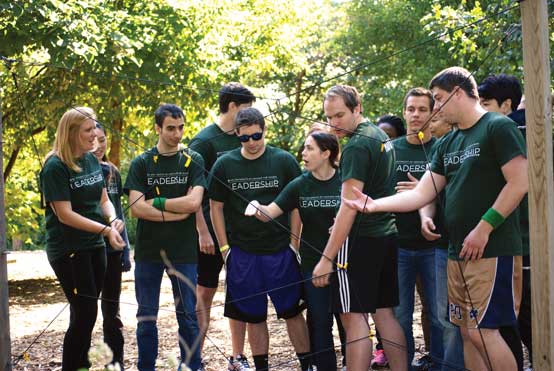
The Hall cohort collaborates on the “spiderweb” task at the retreat. The group must pass each team member through the web without touching it, and each opening must be used once and only once.
In one exercise, part of a Kapnick module called “Building Relationships and Influencing Others,” the facilitators invited students to call out traits they look for in team members. In the session Jasmina Vajzovic was helping lead, participants called out more than three dozen words. When they were finished, Vajzovic divided the words based on their connection to competence (curious, hardworking, big-picture thinker, reliable) or warmth (trustworthy, thoughtful, resilient, self-aware, fun). There were 27 words associated with warmth, but only 10 under competence, a nearly 3-to-1 ratio. “When I did this during my training in the spring, I was shocked,” Vajzovic said. “You think it’s going to be all about competence, all about what you know. But then when you think about it for five minutes, it makes sense. Especially at an institution like this where we all come out competent — you need to be able to differentiate yourself.”
This was a message that resonated with students. “I think often when people go to law school and become attorneys, they assume they have to be cold-hearted, ruthless, impersonal, and almost robotic,” Rossman said. “It was great for us to learn that that’s not the case and, in fact, what can distinguish us and make us successful is not just our technical competence but also our warmth and ability to connect. It’s something that society at large knows and understands, but I had not associated with the legal profession.”
These realizations signaled a growing shift among students who had been through Kapnick: instead of tweaking their behavior and leaving it at that, students were incorporating the lessons into their thinking about relationships, careers, and what it means to be a successful lawyer.
For instance, Eric Lewin, ’17, learned to think about the effectiveness of feedback and to focus on responding to and learning from others. “You might think you’re being helpful, but it is important to recognize how other people are reacting to you,” he said.
Sai Yarramalla, ’17, learned that his tendency to be reserved can sometimes make him appear underconfident. After Kapnick, he found himself thinking about the impression he made on others, and he began pushing himself to be more vocal and to consider new ideas more readily. “I’ve been able to build relationships with my peers more easily, and when I go out to networking events, it’s much easier for me to meet people and relate to them,” he said. “That’s because of Kapnick.”
Kapnick’s facilitators, who went through the program last spring as part of their training, saw the growing impact of these skills in summer jobs. Vajzovic, for instance, felt it on her first day as a summer associate in the Chicago office of Perkins Coie. “I had always had a hard time feeling like a professional, and feeling like part of the group because I saw myself as young and inexperienced, and so I wasn’t as willing to speak up,” Vajzovic said. “But once I became aware of that, I learned to work through it. On my first day at Perkins Coie, I walked in and shook everyone’s hand, and they saw me as a professional. I was a summer associate who deserved a job, and deserved to come back as an attorney. Even now, as I’m speaking, I’m composed and professional. A year ago, I probably would have been giddy and laughing.”
Other facilitators described similar experiences: a deeper confidence, visible professionalism, a greater ability to contribute effectively to discussions. This is the interpersonal polish that law firm and corporate leaders had identified as the missing piece in many young lawyers; it is the gap Kapnick was established to bridge.
“I think the value and the impact of this program will continue to grow as the students apply their insights during law school, then graduate and realize they’re approaching meetings with clients and colleagues in a different way, and with a different mindset,” said Kapnick planner Terri Brady, the Senior Leadership Development Coach at Booth and a former practicing lawyer.
Once they have graduated, the demands of the legal marketplace will encourage more growth, and the dominos will continue to tumble.
“As a lawyer now you have to be more nimble, more flexible, and you should have a higher degree of emotional intelligence: a deeper understanding of yourself and a clearer understanding of the importance of empathy.” Brady said. “Hierarchies are breaking down in the business world, so of course they’re breaking down in the intersection between business and law. We used to picture the solitary lawyer working alone. Now we have a new model: collaboration. You have to be a skilled team player because clients know teams will produce a superior result.”
It wasn’t surprising to Brady that the Law School led its peers in recognizing this shift and responding with a robust program. “Smart people are innovators and change agents,” she said. “Kudos to Dean Schill and to the Dean of Students’ Office for working with the Visiting Committee. They all ‘get it’ because they have practiced law and spent time thinking about ‘lawyers as leaders.’ I’m not at all surprised the Law School supported this type of program. This is exactly the place where I would expect people to have the vision and the wisdom to know that the action skills we work on in the Kapnick program are so critical.”
***
Still, Kapnick was a bit of a trust fall for the Law School. Schill and others were skeptical at first, and they wondered whether “soft skills” had a place in a law school known for its deep intellect and demanding academics.
But it had also become increasingly clear in conversations with alumni that this was an idea whose time had come. Their message was clear: even the brightest students can’t afford to be interpersonally underequipped.
“The change in the landscape means you’re not going to get this leisurely training; nobody’s paying for that anymore,” Diana White, ’81, Executive Director of LAF, the largest provider of legal aid in Cook County, told students during a panel discussion at orientation. “And in my world, it’s not even a question of the client paying, we just don’t have that money. So we’re looking for people who are able to work well with other people, who can operate with co-counsel, who will take care of relationships, who will be attentive and respectful. It’s a lot more than what’s covered in a law school curriculum.”
Added David Tanury, ’11, an attorney with the US Department of Labor: “It becomes relationship-oriented very quickly. And the technical skills, while important, aren’t usually what set you apart.”
This is both an advantage and a challenge, Schiff Hardin’s Riley told students. “It’s good news because you all have the capacity to do this,” he said. “The bad news is there’s no formula for it.”
Although some students clearly wished for a formula — and a few even balked at the it’s-up-to-you message — the absence of clear, uniform instructions was intentional.
“Part of the wisdom here is to create a platform that allows people to take away what matters to them,” Anderson said. “Too many of the leadership development things that occur out there in the business world take people and put them through the same things, on the same schedule — the underlying assumption is that everyone needs the same thing and in the same doses, which is not the case. With Kapnick, people processed things differently, but they had gotten a lot of the big-picture things we hoped they would: the importance of relationships, the importance of thinking about how other people react to you, and how enduring that is. They understood how important warmth and likeability really are and how it can impact their ability to get things done.”
The Law School had a strong foundation on which to build Kapnick. It already had experience with an existing Law School framework, the Keystone Professionalism and Leadership Program—a series of practical talks, trainings, and workshops that started in 2011 and has seen increased attendance since Kapnick launched. In addition, every part of Kapnick is deliberate and rooted in Booth’s years of experience with LEAD, as well as research from a variety of realms: business, psychology, economics, and sociology. Some of these studies are presented directly to students as part of the classroom work, but much of it remains in the background. It is studied by the Law School’s twelve Schiff Hardin facilitators and their counterparts from Booth and used by the planners to inform the order, structure, and content of the lessons and exercises.
Despite the high level of preparation, experience, and research, everyone was prepared for the uncertainty that comes with any start-up initiative—a bumpy rollout, perhaps, or backlash from skeptics who would fail to see the real-world significance and assume that the program was feel-good fluff. And, sure enough, many of the students said they were initially cautious; some even pushed back in group discussions, which is exactly what the planners and facilitators had expected from students preparing for a career that values skepticism.
But, relatively quickly, the lessons began to click, cascading through the class. Students were receptive, even responding well during the uncomfortable moments, such as when they were reading first-impression feedback from fellow students. “I was surprised by how reflective people were,” facilitator Sarah Kang, ’15, said. “Students were candid in sharing the negative feedback they had received and also in admitting that they had made efforts to connect socially with some people in the group but not with others. They really looked at the information and thought about the implications.”
Throughout the entire program, facilitators acted as close observers, providing frequent and individualized feedback designed to guide rather than conclude.
“We’re not the ones who know what’s right or wrong — our purpose is to build awareness,” said facilitator Andrew C. Adair, ’15. “For instance, if someone was too loud, we didn’t say, ‘You were too loud,’ — we asked them what they saw watching the video, and they identified the behaviors. Then we encouraged them to think about how those behaviors might be seen by others, how they might affect group dynamics, and whether there’s anything they want to enhance or correct. I was really nervous about these sessions because it was my first time doing one-on-one feedback. But it wasn’t as hard as I thought. In all my experiences, the students came at me right away with things they wanted to think about. It was surprising. It was great.”
Several students said that while it wasn’t exactly fun to identify weaknesses, they also learned a lot about how some of those same traits could be, and often were,channeled in highly productive ways. “I learned that sometimes I dominate conversations, but I also learned that I’m good at supporting people who might not be so vocal,” Rossman said.
Adair said it was exciting to watch students actively incorporating the insights, gradually improving their effectiveness, likeability, and ability to influence others. “Kapnick is all about benchmarking and developing self-awareness,” he said. “It’s figuring out where you are and where you want to go.”
This was a common theme in Kapnick: one size rarely fits all. There are core qualities that matter, but there are different, equally valid, ways to express many of them.
Or as facilitator Erica Jaffe, ’15, put it during the Personality and Leadership workshop: “There is no profile for a leader.”
When she said this, she was getting ready to hand back the results of the Hogan Personality Inventory, which measures traits along seven scales — response style, assertion, sociability, interpersonal sensitivity, prudence, inquisitiveness, and learning approach. She wanted to be clear: there was no “winning” formula. For instance, someone who scored on the far right of the assertion scale might be energetic, competitive, self-assured, and willing to take initiative — but might also be overly dominant or a poor listener. Someone on the far right of the interpersonal sensitivity scale might be friendly, engaging, and cooperative — but be thin-skinned and have difficulty handling conflict.
“It’s great to know what your default tendencies are,” she said. “But where it really matters is how it informs your interactions.”
***
Cohen had always assumed that his default was to let others take charge. A thinker and observer by nature, he noticed that his teammates also had default settings: in every challenge, it was the same people giving the orders. At one point, he even commented to a teammate that he found it thought-provoking: the leaders were always leaders, the followers were always followers.
But then his team took on a challenge that involved traversing an area by walking entirely on heavy beams that needed to be lifted and repositioned as they moved along — a task that required strategy, coordination, and leadership. As the challenge unfolded, Cohen found himself stepping outside his comfort zone in ways that surprised him. Ways that felt good.
“I felt for a moment that I could let go of my fears of leading and just take on a leadership role, even though I’d been in the background at first,” Cohen said. “I just saw a hole or a vacuum where I could put myself.”
Even when the facilitators told him he couldn’t talk, Cohen used eye contact and gestures to communicate with his teammates; it all came so … naturally. In the back of his mind, he worried slightly that he might be “pushing other people out” by stepping up, but nobody else gave any indication that they resented his role.
“It struck me that this is what leadership is supposed to feel like — it’s not forced at all, it’s just collaboration,” Cohen said. “I’m not a natural leader, but something about the activity flipped a switch.”
This was the type of experience Kapnick’s planners had hoped, and expected, to see early on — a step that would trigger other steps and gradually lead students to a level of interpersonal development they otherwise might not have seen until midcareer.
For Cohen and his classmates, the full effect of the Kapnick Initiative will be most evident in a few years — perhaps when they’re new lawyers, taking on leadership positions earlier, or working their warm connections to accomplish a goal, or finding that they rally the support of a team more easily than other new hires.
“The impact of Kapnick will continue long after the program has ended,” Gardner said. “That’s what will be most exciting — seeing all of the different ways in which this plays out for our students. This program isn’t about overnight transformation. It’s about laying the groundwork for a critical set of skills that have the power to change their careers and their lives.”
